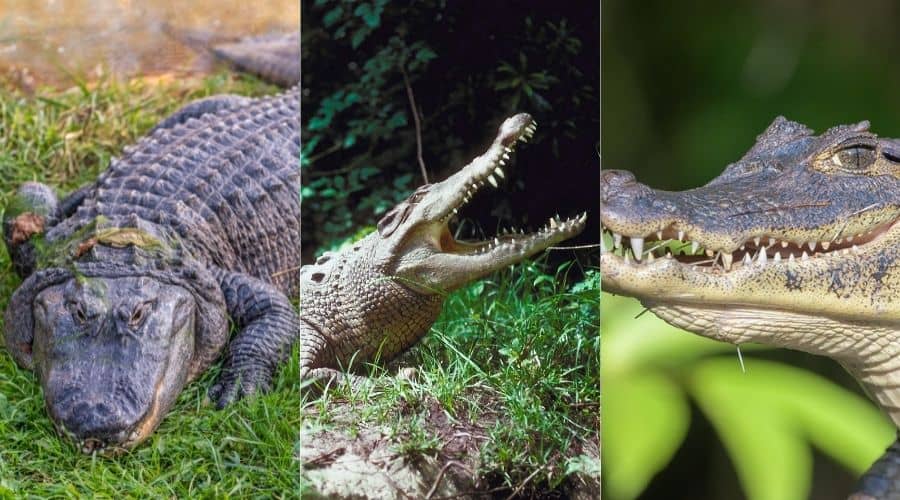The crocodilian family of reptiles appeared around ninety-five million years ago during the Late Cretaceous period. This family of large, semi-aquatic, lizard-like predators includes different species like crocodiles, caiman, and alligators.
Crocodilians are all similar but not identical. What’s the difference between an alligator, a crocodile, and a Caiman?
Caimans, crocodiles, and alligators are different species that belong to the same reptile family. Caimans are smaller but more aggressive than alligators and both have a rounded U-shaped snout with an overbite. Crocodiles are the largest and most aggressive, growing up to 23 ft long and weighing around 2,000 pounds. They have a distinctly V-shaped snout with no overbite and dagger-shaped teeth.
Table of Contents
What Is The Difference Between A Caiman, A Crocodile, And An Alligator
Caimans, crocodiles, and alligators are entirely different species within the same reptile family.
Alligators get up to 1,000 pounds and 14 feet long, which is impressive but not as sizeable as saltwater crocodiles, which can be 23 feet long and weigh over 2,000 pounds.
Caimans have six species, but they average much smaller than their croc and gator cousins at around six and a half to eight feet for most species.
However, the largest caimans almost rival saltwater crocodiles and can get up to twenty feet long.
Other than face shape and general size, one of the easy ways to spot the differences between these three species is their home.
Caimans live in central and South America. American alligators typically live in the southern swamps, especially Louisiana and Florida. Meanwhile, crocodiles are the widest ranging
According to Live Science, “Today, crocodiles are found in the tropical habitats of Africa, Asia, Australia, and the Americas. They normally live near lakes, rivers, wetlands, and even some saltwater regions.”
What Is The Difference Between A Caiman And An Alligator
The differences between caimans and alligators are most evident in the mouths and heads of each species. For example, alligators have conical teeth, and caimans have sharper, more knife-like teeth.
Additionally, alligators have an overbite, and caimans tend to have a more even smile. Other differences include the set of their eyes. Caimans have big, high-set eyes, while alligators are more petite and set into their heads.
However, both species have similar tough, scaly hides, lifestyles, and diets. Caimans and alligators can even live in the same environment.
The two species are in the same family of crocodilians, so they are more closely related to each other than crocodiles or gharials.
What Is The Difference Between A Crocodile And Caiman
One of the most significant differences between a crocodile and a caiman is that caimans are thriving, but crocs appear to be dying out.
Sadly, some of the thirteen species of crocodiles are critically endangered, like the Cuban and Siamese. Only the saltwater crocodile has a population that is over two hundred thousand. The rest are half that or less in the wild.
According to Kidadl, “… it is estimated that there are more than one million black caimans and Cuvier’s dwarf caimans, more than three million of the spectacled caiman (Caiman crocodilus), 250,000 to 500,000 broad-snouted caiman (Caiman latirostris), more than 200,000 yacare caiman (Caiman yacare), and more than one million smooth-fronted caimans (Paleosuchus trigonatus).” In short, there are a lot of caimans.
Crocodiles and caimans have a similar diet. As semi-aquatic predators, they eat smaller creatures and fish found in the regions where they live.
Crocs are located in the tropical areas of most continents. Meanwhile, Caimans are more aquatic and live in rivers, marshes, and mangroves from Mexico to South America.
Are Caiman Bigger Than Alligators
Caiman average around 88 pounds. However, the black caiman can weigh up to 2,400 pounds and reach 16 feet long. That said, even the most giant Caiman doesn’t match the size of the larger alligators.
Is A Caiman Bigger Than A Crocodile
Caimans are not larger than crocodiles. Of all the crocodilians, the crocodile is the largest by weight and length.
The saltwater crocs are the largest, which makes perfect sense given the vastness of the sea. Swimming with literal sharks and killer whales requires a tough hide and enough size to stay off the menu.
The caimans are aggressive, and they get large enough to be a serious problem to anything they attack, even a crocodile.
Plus, they live in groups, which makes them more of a concern. Still, the crocodile has the most extraordinary sheer size, if only by about three feet.
Plus, they weigh substantially more because a layer of fat keeps them protected from the cold in the ocean.
Are Caiman More Aggressive Than Alligators
Caimans are more aggressive than alligators. In fact, the American alligator is dangerous enough that you should avoid it, but as crocodilians go, this species is relatively tame and docile compared to its peers.
An alligator will walk away from a fight unless it’s hungry or the altercation is unavoidable.
Although caimans are often smaller than alligators, they also travel in groups. This species has been known to hunt in teams, so it’s bad news for any creature they choose to target.
Are Crocodiles More Dangerous Than Alligators
Crocodiles and alligators are both significantly dangerous apex predators. Both have their advantages.
For example, an alligator is more likely to catch you on land and in the water. Meanwhile, the enormous crocodile has a more massive mouth with a stronger bite.
Ultimately, there is danger from both, but the crocodile is probably more problematic.
Crocs are known for being more aggressive naturally, will strike out more often with less reason, and have even been observed looking for trouble. Alligators tend to wait until they are hungry or threatened before lashing out.
However, not all crocodiles are created equally. Some species are more prone to violence than others.
According to National Geographic’s Adam Rosenblatt, “Nile crocodiles are generally considered to be much more aggressive than American alligators or American crocodiles.”
Is An Alligator Faster Than A Crocodile
Alligators are substantially faster than crocodiles. There are two critical types of locomotion for these giant reptiles, running and swimming. The alligator has the advantage in both, and it’s not even a close race.
The average human can run at roughly six and a half to eight miles per hour. A crocodile can easily outpace us at twenty mph, fast enough to catch a slow car.
However, the alligator can hit speeds of thirty mph, so they’d easily catch up and pass most creatures in a foot race.
Likewise, in water, a crocodile is slower. Their top speed, around eighteen miles an hour, is fast enough to catch people and many other things that swim.
However, the alligator can use its powerful tail to hit speeds of twenty-eight miles an hour, which is barely less than its land speed.
Which Is More Powerful, Alligator or Crocodile
Most animals don’t arm wrestle, so judging their strength is not about grip or ability to punch. While the ability to swim, dig and even roll over can all help win a fight, there’s something that matters more.
For alligators and crocodiles, the jaw is the most powerful and vital part of their bodies.
At twice the weight and several feet, longer crocs have the advantage. Since crocodiles grow larger than alligators, they also have a bigger jaw.
A crocodile’s bite force is 3,700 psi or pounds of pressure per square inch, a lot more than the alligators 2,980 psi.
Crocodile Nose vs Alligator Nose
Alligators and crocodiles can easily be told apart by looking at their noses. An Alligator has a shorter, wider nose that is U-shaped. Additionally, it has noticeably smaller eyes that don’t stick up very far.
Alternatively, the crocodile has a more petite and pointer head, but also longer. Croc’s have a V-shape rather than a U.
Moreover, the crocodile’s bigger eyes sit on top of its narrow head and stick up further.
Helpful Tips To Know About An Alligator Vs. Crocodile Vs. Caiman
Although the general look of alligators, crocodiles, and caiman are very similar, they are distinct species. It is easy to mistake one crocodilian for another on casual inspection because they are all massive predatory reptiles who live, mate, and feed similarly.
Here are a few more helpful tips to know about an alligator vs a crocodile vs a caiman.
- Unlike dog or cat species, different crocodilians cannot mate. You will never find a caima-gator or an alli-odile in nature, no matter how many of these similar crocodilian creatures might accidentally meet due to human intervention.
- According to Science.org, “North American fossils from 70 million years ago revealed a common ancestor of both alligators and caimans that lived during that time. And a plethora of more-recent caiman fossils have been discovered in South America, implying that their ancestors at some point crossed between the continents.”
- There are twenty-four species of crocodilians in three distinct families. Crocodylidae is the largest, with fourteen species, including “true” crocodiles. Alligatoridae has eight species and contains alligators and caimans, and Gavialidae only contains Gharials and Tomistoma.
Final Thoughts
The difference between a caiman, a crocodile, and an alligator mostly comes down to where it migrated a stunning seventy million years ago when they were still one common species.
Over hundreds of thousands of years, different environments, prey items, and physical needs slowly changed and evolved them into separate crocodilians.
Eventually, the three species became so isolated from one another and so unique that they are no longer the same.
Despite the cosmetic, climate adaptive, and lifestyle differences, these three giant reptiles are still very similar, so don’t feel too bad if you aren’t sure which one you’re seeing at first glance.


